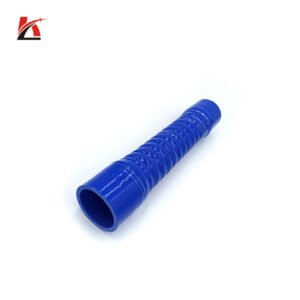The production method for silicone hoses with varying degrees of flexibility can be adjusted to meet specific requirements for different applications. The flexibility of silicone hoses is influenced by several factors, and the production process can be tailored to achieve the desired level of flexibility.
Here are some considerations that differentiate the production methods for silicone hoses with varying degrees of flexibility:
- Material Selection:
- The type and formulation of silicone polymer used in the production can be adjusted to influence the flexibility of the final product. Different grades and additives can impact the flexibility characteristics.
- Duvet and Hardness Parameters:
- The duvet (softness) and hardness parameters of the silicone material can be controlled during the mixing stage. This involves adjusting the ratio of raw materials and the curing process to achieve the desired flexibility.
- Polymer Chain Length:
- The length of silicone polymer chains can be modified to affect the flexibility of the material. Shorter chains generally result in a more flexible silicone, while longer chains contribute to stiffness.
- Reinforcement Material and Structure:
- The type and arrangement of reinforcement materials, such as fabric or wire, can impact the flexibility. Varying the reinforcement structure or using different materials allows for customization.
- Curing Process:
- The curing time, temperature, and pressure during the vulcanization process can be adjusted to achieve different degrees of cross-linking, influencing the final flexibility of the silicone hose.
- Post-Curing Treatment:
- Post-curing processes, which may involve additional heating or treatment, can be employed to further enhance or modify the flexibility characteristics of the silicone material.
- Wall Thickness:
- The thickness of the hose walls can influence flexibility. Thinner walls may contribute to increased flexibility, flexible silicon hose while thicker walls may result in a stiffer hose.
- Design of Hose Structure:
- The overall design and construction of the hose, including the number and arrangement of layers, can impact flexibility. Single-layer hoses may be more flexible than multi-layered ones.
- Additives for Softening or Stiffening:
- Specific additives, softeners, or stiffeners can be introduced during the production process to tailor the flexibility of the silicone material based on application requirements.
- Testing and Quality Control:
- Rigorous testing protocols can be implemented during and after production to ensure that the flexibility of the silicone hoses meets the specified standards and requirements.
- Customization for Applications:
- The production method can be customized based on the intended application of the silicone hose. For example, hoses designed for medical applications may require a different level of flexibility compared to those used in industrial settings.
- Environmental Considerations:
- External factors, such as temperature and exposure to chemicals, can affect the flexibility of silicone hoses. Production methods may be adjusted to enhance resistance to environmental influences.
By considering these factors during the production process, manufacturers can produce silicone hoses with varying degrees of flexibility to meet the specific needs and preferences of different industries and applications.
